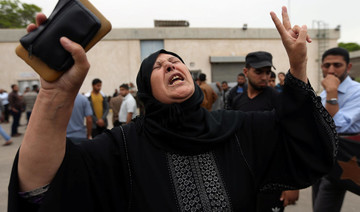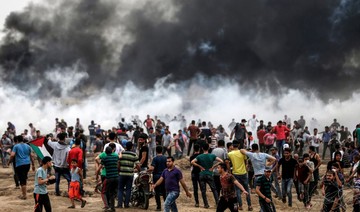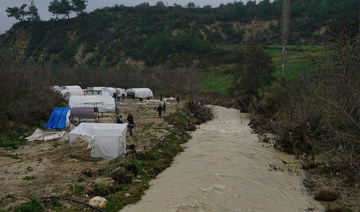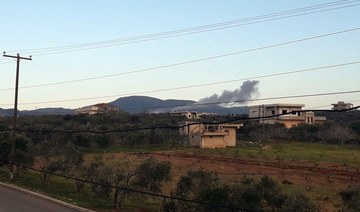JERUSALEM: The Israeli military said Saturday it was shutting down its main cargo crossing into Gaza after Palestinian protesters caused extensive damage to it, and that it had also destroyed an attack tunnel dug near its main pedestrian crossing.
The twin developments come ahead of a potentially charged week along the Israel-Gaza border as weekly protests being staged there are expected to culminate with a potential breach of the border and a surge in casualties.
Once again, thousands of Palestinians protested Friday in various locations along the frontier. Later, a group of Palestinians burned a fuel complex and conveyor belt on their side of the Kerem Shalom crossing, causing more than $9 million in damages and disrupting the import of diesel fuel and building materials, the military said. It said the attack rendered the main fuel and gas lines unusable and caused further damage to electrical infrastructure and other vital equipment.
The military said the Kerem Shalom crossing will be closed until further notice and not before the damage is repaired.
A lengthy closing of the crossing would deliver further devastation to Gaza's already dire humanitarian crisis. The fuel installation is the only way to bring diesel fuel into Gaza for operating generators for hospitals and other key facilities. The military distributed a video showing Palestinians cheering as a fire was set. It was the second such attack on the facility in a week, it said.
Late Saturday, the military carried out several airstrikes in the northern Gaza strip, near the Erez border crossing, to destroy a Hamas tunnel that was being built there. Lt. Col. Jonathan Conricus, a military spokesman, said the tunnel was being tracked for weeks and had been destroyed just a few meters (feet) inside Gaza. It's the sixth such Hamas tunnel Israel has destroyed in as many months due to the military's new technological means to detect and destroy them.
Hamas called the airstrikes a "failed attempt" to prevent protests.
"Our people's response will come on Monday by marching" to the fence, it said in a statement.
Conricus said the military was doubling its troops along the border in advance of this week's protests and that Israel would not allow the area to become an active combat zone.
An extended closing of the cargo crossing could be particularly painful. Cooking gas and fuel, which are delivered to Gaza through Kerem Shalom on a daily basis, are the first and most essential items likely to be affected. A fear of shortage had already engulfed Gaza late Saturday, as more cars were lining up at gas station to stock on diesel and gasoline.
The Hamas-run petrol authority in Gaza ordered that cooking gas not be provided to people with canisters on Sunday. "This is to measure how much we have and to see how much this can serve the citizens," said Khalil Shaqfa of the petrol authority.
Palestinians in Gaza have been staging weekly protests at the border fence against a decade-old blockade of the territory. The demonstrations have been organized by Gaza's Hamas rulers, but are fueled by despair among the territory's 2 million residents. The vast majority are barred from travel and trade, while the blockade has gutted the economy.
A Palestinian was killed and 175 were wounded by Israeli army fire on Friday. The Palestinian health ministry said a teenage boy died Saturday after he was shot in the head by Israeli fire on the Gaza-Israel border.
The death raises to 42 the number of Palestinians shot dead by Israeli forces since weekly protests began on March 30. More than 1,800 have been wounded. The coming week could see a further uptick in violence, as Palestinians are planning much larger protests to coincide with the United States relocating its embassy in Israel to Jerusalem on Monday and the 70th anniversary of their "nakba," or catastrophe — referring to their mass uprooting during the Mideast war over Israel's 1948 creation — on Tuesday.
Israel says it has a right to defend its border but rights groups say the use of potentially lethal force against unarmed protesters is unlawful.
Israel and Hamas have fought three wars since 2008. During the most recent conflict in 2014, Israel destroyed 32 tunnels and it has placed a high priority on halting the tunnel threat since Hamas infiltrated Israel during the war. Although they did not manage to reach civilian areas, the infiltrations caught Israel off guard, with one attack killing five soldiers, and terrified the local population.
Israel is building a subterranean barrier to detect and prevent attack tunnels. Israel says the barrier, as well as new technological innovations, have rendered the Hamas tunnel project futile.
Israel bombs Gaza tunnel, closes key crossing after attack
Israel bombs Gaza tunnel, closes key crossing after attack

- The Kerem Shalom crossing will be closed until “extensive damage” is repaired
- Israeli forces struck a one kilometer long Hamas tunnel in northern Gaza
Hezbollah uses new weapons in Israel attacks

- The Israeli army said three soldiers were wounded in an attack on Thursday
- Hezbollah has a large arsenal of weapons, that it has expanded significantly in recent years
BEIRUT: Lebanon’s powerful armed group Hezbollah announced on Thursday it had used a drone capable of firing rockets at a military position in one of its latest attacks in northern Israel.
Israel and Hezbollah have been involved in near-daily exchanges of fire since the war between Israel and Hamas broke out on October 7.
Hezbollah announced it had used an “armed attack drone” equipped with two S-5 rockets on a military position in Metula in northern Israel.
The Iran-backed group published a video showing the drone heading toward the position, where tanks were stationed, with the footage showing the moment the two rockets were released followed by the drone exploding.
It was the first time they had announced the use of this type of weapon since the cross-border exchanges with Israel erupted in October.
The Israeli army said three soldiers were wounded in Thursday’s attack.
Hezbollah-affiliated media said that the drone’s warhead consisted of between 25 and 30 kilogrammes (55 and 66 pounds) of high explosive.
Military analyst Khalil Helou told AFP that the use of drones offers Hezbollah the ability to launch the attack from within Israeli territory, as they can fly at low altitudes, evading detection by radar.
Hezbollah also announced on Wednesday that it had launched a strike using “attack drones” on a base west of the northern Israeli town of Tiberias.
That attack was the group’s deepest into Israeli territory since fighting flared, analysts said.
In recent weeks, the Lebanese militant group has announced attacks that it has described as “complex,” using attack drones and missiles to hit military positions, as well as troops and vehicles.
It has also used guided and heavy missiles, such as Iran’s Burkan and Almas missiles, as well as the Jihad Mughniyeh missile, named after a Hezbollah leader killed by Israeli fire in Syria in 2015.
Helou, a retired general, said that depite its new weaponry, Hezbollah still relied primarily on Kornet anti-tank missiles with a range of just five to eight kilometers.
They also use the Konkurs anti-tank missile, which can penetrate Israel’s Iron Dome defense system.
Hezbollah has a large arsenal of weapons, that it has expanded significantly in recent years.
The group has said repeatedly that it has advanced weapons capable of striking deep inside Israeli territory.
Analysts have described the skirmishes between Israel and Hamas as a war of “attrition,” in which each side is testing the other, as well as their own tactics.
Hezbollah has expanded the range of its attacks in response to strikes targeting its munitions and infrastructure, or its military commanders.
One such Israeli strike on Wednesday targeted the village of Brital in Lebanon’s eastern Bekaa Valley, with the Israeli army later announcing it had hit a “terror target related to Hezbollah’s precision missile project.”
Helou said Hezbollah’s targeting of the base near Tiberias and its use of the rocket-equipped drone “can be interpreted as a response to the attack on Brital, but it remains a shy response compared to the group’s capabilities.”
He suggested that the Israeli strike likely hit a depot for Iranian missiles that had not yet been used by Hezbollah.
“Hezbollah does not wish to expand the circle of the conflict,” Helou said.
“What is happening is a war of attrition through which it is trying to distract the Israeli army” from Gaza and seeking to prevent it from “launching a wide-ranging attack on Lebanon.”
US officials held indirect talks with Iran on avoiding regional escalation: report

Two top Biden administration officials held indirect talks with Iranian counterparts this week in an effort to avoid escalating regional attacks, Axios reported on Friday.
The conversations marked the first round of discussions between the US and Iran since January, according to Axios.
One Palestinian killed, eight wounded in Israeli strike on West Bank refugee camp

- Israel has killed more than 35,000 Palestinians, according to Gaza’s Health Ministry
RAMALLAH, West Bank: At least one person was killed and eight wounded on Friday in an Israeli air strike on the Jenin refugee camp in the occupied West Bank, the Palestinian health ministry and Israeli military said.
The Palestinian health ministry said the eight wounded people were in stable condition and receiving treatment at hospitals. Reuters could not immediately confirm their identities.
The Israeli military said a fighter jet conducted the strike, a rarity in the West Bank, where violence had been surging long before the Gaza war.
Residents of the refugee camp said a house was targeted.
The West Bank is among territories Israel occupied in a 1967 Middle East war. Palestinians want it to be the core of an independent Palestinian state.
Trapped US doctors are out of Gaza, White House says

- The Palestinian American Medical Association, a US-based non-profit, reported that its team of 19 health care professionals, including 10 Americans, had been denied exit from Gaza after their two-week mission
- Israel has killed more than 35,000 Palestinians in Gaza, mostly women and children, according to the health ministry in the Hamas-run territory
WASHINGTON: A group of US medical workers left the Gaza Strip after getting stuck at the hospital where they were providing care, the White House said on Friday.
Reports emerged earlier this week of American doctors being unable to leave Gaza after Israel closed the Rafah border crossing, including 10 from the US-based Palestinian American Medical Association, who had intended to leave after a two-week mission at the European Hospital in Khan Younis, a city near Rafah in southern Gaza.
On Friday, 17 American doctors and health care workers, out of a total of 20, got out of Gaza, White House national security spokesperson John Kirby told reporters.
“I can assure you that any of them that wanted to leave are out,” Kirby said.
A State Department spokesperson told Reuters that some of the doctors that had been stuck made their way to safety with assistance from the US Embassy in Jerusalem.
Three of the US doctors chose not to depart Gaza, a source familiar with the situation said, adding that the doctors who stayed behind understood that the US Embassy may not be able to facilitate their departure as it did on Friday.
The Palestinian American Medical Association, a US-based non-profit, reported that its team of 19 health care professionals, including 10 Americans, had been denied exit from Gaza after their two-week mission.
The organization said on social media on Wednesday that it had a more doctors waiting to enter Gaza to replace the workers trying to leave.
Israel seized and closed the Rafah border crossing between Gaza and Egypt on May 7, disrupting a vital route for people and aid into and out of the devastated enclave.
Gaza’s health care system has essentially collapsed since Israel began its military offensive there after the Oct. 7 cross-border attacks by Palestinian Hamas militants on Israelis.
Aid deliveries began arriving at a US-built pier off the Gaza Strip on Friday.
Protests against powerful group persist in Syria’s last major rebel stronghold

- Protests took place Friday in several areas, including the provincial capital of Idlib and major towns such as Jisr Al-Shughour, Binnish and Sarmada
- Officials at one hospital in Binnish said they had received 36 people who suffered bruises and tear gas inhalation
IDLIB, Syria: Members of a powerful insurgent group in Syria ‘s rebel-held northwest fired into the air and beat protesters with clubs Friday, injuring some of them as protests intensified to demand the release of detainees and an end to the group’s rule.
Protests took place Friday in several areas, including the provincial capital of Idlib and major towns such as Jisr Al-Shughour, Binnish and Sarmada.
They came days after Abu Mohammed Al-Golani, the leader of Hayat Tahrir Al-Sham, or HTS, described the demonstrators as anarchists and told dignitaries in Syria’s Idlib province to persuade them to stop protesting.
The protests, which are calling for the ouster of Al-Golani, broke out in late February following the death of a member of a rebel faction, allegedly while being tortured in a jail run by HTS, which previously had links to Al-Qaeda. Since then, HTS released hundreds of detainees, but many remain in jails run by the group’s so-called General Security Agency.
“I came out against injustice. We don’t want Al-Golani and we don’t want the security fist. We want the prisoners of opinion to be out” of jails, protester Mazen Ziwani told The Associated Press.
Officials at one hospital in Binnish said they had received 36 people who suffered bruises and tear gas inhalation.
After more than 13 years of civil war and more than half a million deaths, Idlib is the last major rebel stronghold in Syria.
On Tuesday, HTS members attacked protesters with clubs and sharp objects outside a military court in Idlib city, injuring several people.
Anti-HTS sentiments had been rising since a wave of arrests by the group of senior officials within the organization, which was previously known as the Nusra Front, when it was Al-Qaeda’s branch in Syria, before changing its name several times and distancing itself from Al-Qaeda.
Over the years, Al-Golani’s HTS crushed many of its opponents to become the strongest group in the rebel-held region that stretches to the western parts of Aleppo province.
The Britain-based Syrian Observatory for Human Rights, an opposition war monitor, said HTS fighters closed major roads leading to Idlib city Friday to prevent the demonstrators from reaching the provincial capital.
Over the past years, HTS has been trying to distance itself from Al-Qaeda and market itself as a more moderate Syrian opposition group after years of strict religious rule.
In 2017, HTS set up a so-called “salvation government” to run day-to-day affairs in the region. At first, it attempted to enforce a strict interpretation of Islamic law. Religious police were tasked with making sure that women were covered, with only their faces and hands showing.
The police would force shops to close on Fridays so that people could attend the weekly prayers. Playing music was banned, as was smoking water pipes in public.

















